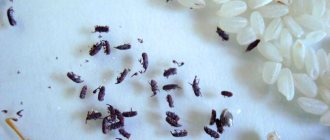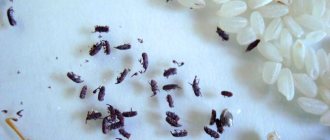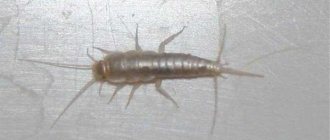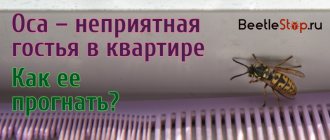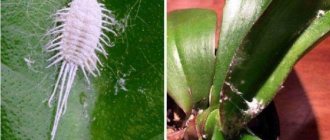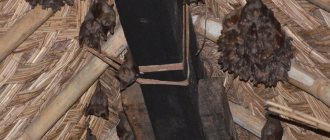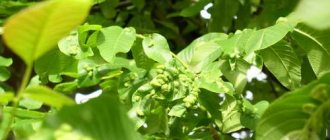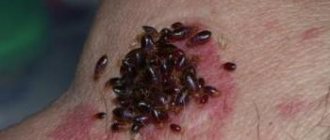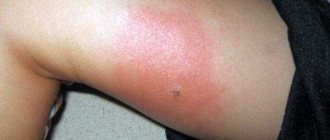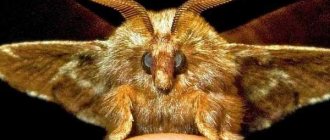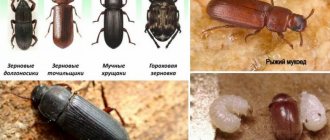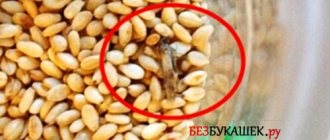A small butterfly flying through your kitchen is a serious enough reason to start worrying about the safety of your food. Most often, parasites feed on cereals and grains; moths are also often found in dried fruits. These insects feed while at the caterpillar stage, making small holes in dried fruits and entangling themselves in a silk cocoon.
What does food moth look like?
This pest belongs to the order of Lepidoptera butterflies. The body length does not exceed 1 cm. The main color is gray, but black horizontal stripes are clearly visible on it, which distinguishes this species from others.
The front wings of the food moth are narrow-lanceolate and pointed. The hind ones are wider with a characteristic fringe along the edge. The fruit moth has large eyes and also has sensitive antennae that help it accurately find foods where it can lay eggs.
The peculiarity of this inconspicuous butterfly is that it does not have a proboscis. This is due to the fact that during the transformation into a sexually mature individual, the insect loses not only the ability to eat, but also to digest food, so there is no need for this organ.
The eggs of the pest are oval. Their size is approximately 0.5 mm. The shade of their shell changes. It is initially milky white and later turns yellow-orange. During oviposition, females secrete a sticky secretion, which allows the eggs to be securely attached to the surface of food.
Larvae and adults of the pest
The caterpillar larvae of food moths are light in color, only the head is darker. They move well and are characterized by increased gluttony, as they have a well-developed gnawing-type mouthparts. For this pest, cellophane and cling film are not an obstacle. As they grow older, their color changes and becomes milky white. The body of the caterpillars is shortened.
The pupa of the food moth reaches 6-6.5 mm in length. Initially it has a straw-yellow hue, and later becomes dark brown. The development of the food moth pupa occurs in dried fruits. This process takes from 7 to 15 days. Then a new sexually mature individual appears, which is ready to breed within a day.
It is quite difficult to detect the appearance of moths in dried fruits at the initial stage of infection. The insect is nocturnal and prefers to hide from daylight.
How to get rid of moths in dried fruits using folk remedies
Getting rid of fruit moths is difficult - this voracious insect is not so easy to detect at the very beginning. The fact is that adults are already flying around the kitchen, but they don’t eat anything at all. Their main goal is to find a secluded place and lay eggs there, from which moth larvae will hatch in a few days. It is they who turn delicious dried fruits into real dust.
You can recognize fruit moths by the characteristic stripes on the tips of their wings. It is small in size, only about 1 cm in length.
Look at what the fruit moth looks like in the photo, so that if it appears, you can identify the enemy by the appearance of the moth.
The grown larvae can be seen with the naked eye; they do not look like small worms. They hatch from eggs hidden in a cocoon, as if made from a cobweb.
food moth
Fruit moths can appear not only in dried fruits. An excellent habitat for it are bags of cereals or flour. Moth larvae prefer to eat sweet fruits, but the butterfly can lay eggs in a dry place next to them, and the hatched larvae will crawl to the delicacy on their own.
Fortunately, they do not crawl long distances, so fruit moths can appear in an apartment only in one of the following ways:
- fly through the ventilation ducts and settle in the food cupboard;
- entering the house with a new batch of low-quality dried fruits;
- fly into an open window, especially in the evenings when the lights are on in the windows.
Therefore, it is quite possible to protect yourself from its appearance and it is much easier to do than getting rid of moths in dried fruits.
Is it possible to eat grains and flour infested with beetles?
Food should not be consumed together with insects. Before using cereals, you need to get rid of pests.
However, even careful processing will not be able to remove larvae, scales, and waste products of beetles. They pose no danger to a healthy adult.
Before using cereals you need to get rid of pests
It’s a different matter when it comes to children and people with weakened immune systems. In these cases, the use of such products can cause a severe allergic reaction or cause intoxication of the human body, which will lead to disruption of the functioning of the gastrointestinal tract and an increase in body temperature.
How to protect yourself from moths
To prevent moths from infesting dried fruits, you need to carefully inspect them before purchasing. High-quality dried fruits have a smooth surface, without holes or other visible damage. The holes are made by moth larvae, gnawing into the pulp of dried fruits.
It is necessary to install a mesh with small cells on the ventilation holes, which will allow air to pass freely, but will trap moths and other small insects. To ensure that the mesh does not interfere with the normal operation of ventilation and does not impede air circulation, it must be regularly washed or wiped with a damp cloth, preferably soaked in a vinegar solution.
During the cold season, moths do not fly along the street and, accordingly, can penetrate the window. But in spring and summer, installing a moxite mesh will help protect your apartment from pests, which will not allow them to enter from the street and spoil your products.
Moth in dried apples
Destruction of moths
Methods for killing moths
Where does it come from?
Food moths can get into a person’s home in different ways. Pest larvae may already be in products purchased in stores, since storage conditions in warehouses do not always correspond to the norm. And this leads to the proliferation of the pest. In the absence of dried fruits, moths appear in cereals, flour, tea and nuts. The only things that don't appeal to her are spices and coffee.
Pupae of the pest may also initially be found in fruits that have been used for drying. And since they are subsequently stored in a dry, dark place, such conditions are ideal for further reproduction.
Moths can also fly in through an open window at night. As a result, she finds a favorable place and lays eggs.
Destruction of moths
Methods for killing moths
The moth is not distinguished by its quick reaction or strong flight abilities. It's easy to slam him. But there is no guarantee that this is the only or last butterfly in the room, so you should play it safe and use effective moth repellents in the apartment and in the kitchen in particular.
- Sticky tapes are hung around the kitchen, anti-moth tablets and special traps are used in cabinets.
- Among the folk remedies, herbs such as lavender, peppermint, chamomile, and geranium will help repel the pest. These plants repel moths with their scent. Orange peels and garlic are also excellent repellents.
- Ventilating the kitchen for 20 minutes every evening during cold periods reduces the activity of moths and creates unfavorable living conditions for them.
- In case of severe infestation of the premises, aerosols and moth sprays are used. Initially, they carry out cleaning to destroy the larvae, wipe down the cabinets, and hide the food in airtight containers. Disinsection is carried out. Use any insecticidal agent - Raptor, Raid, Antimol, Clean House, Dichlorvos. After 20 minutes, ventilate, carry out wet cleaning by adding baking soda and laundry soap to the water. An alkaline environment completely neutralizes the effect of the insecticide.
Not only does dry fruit attract moths into the house, any food supplies can become contaminated if the insect gains access to them. Preventative measures are extremely important to prevent infection.
Dried fruit protection
You can prevent the appearance of fruit moths if you take care in advance about the proper storage of food. To do this, it is necessary to prevent a sexually mature individual from laying eggs.
How to save dried fruits from moths?
Favorable conditions for moth reproduction are temperature +250C degrees and humidity within 50%. Infection can be eliminated if you prepare food for storage, select containers and determine the location.
Storing dried fruits
Preparation for storage
To prevent moths from infesting dried fruits, you must first check their quality. To do this, you need to sort through them and remove everything that causes suspicion. Then, as a preventive measure against mold and insects, you should additionally dry them in the oven at a temperature of +60-800C for half an hour.
Attention! The shelf life of dried fruits is 12 months. After this period they should be disposed of.
Selection of containers
To store dried fruits, you must use hermetically sealed glass containers. After pouring the product into them, you need to put a paper napkin on top, which will absorb moisture.
Determining the storage location
Dried fruits must be stored in a dark, dry place where sunlight does not penetrate. The best option may be a shelf in a pantry or closet.
Protective measures
To preserve dried fruits and protect them from moths, it is necessary to check them regularly throughout the storage period. If stickiness appears, dry it in the oven. Also, to prevent high humidity in the storage area, you should place containers with salt nearby, which will absorb excess moisture.
How to store dried fruits
Dried fruits should be stored properly. Only if special conditions are met can you count on the fact that the quality of the product will not suffer, and it will retain all the useful vitamins and microelements, and will not harbor moths:
Air temperature and humidity
The optimal temperature for storing dried fruits is no higher than +100C. It is important that the air humidity is within 65-75%. If storage conditions are inappropriate, chemical processes are accelerated, which leads to premature spoilage, and this is also a provoking factor for the appearance of a pest.
How to save?!
How to get rid of worms in dried fruits - there are worms in the dryer, what should I do?
It is not difficult to detect insects in dried apples: at the bottom of the container in which they are stored, you can see white worms, light lumps, and the remains of cocoons of moth larvae. Moths are capable of multiplying everywhere: not only in dried fruits, so it will not be difficult to detect traces of its presence inside cabinets, on the walls of furniture or premises.
Moth in dried apples
How to get rid of fruit moths and protect dried fruits from them
Very often, dried fruits suffer from personal pests. Having sent dried apricots or figs for storage, after a while you may be surprised to find that they have become unusable. The fruit moth does not neglect other food: its larvae destroy banal dried apples brought from the village for compote and exotic tropical dried fruits with equal ease.
Description of the appearance of the pest
The very name of fruit moth is collective. Both grain and granary varieties are not averse to eating delicacies such as nuts or dried fruits.
If desired or necessary, they quickly switch their food priorities. However, in their many rows there is also a dried fruit moth, which is called more simply and briefly - fruit moth.
Similar species, differing little in description and way of life: fig and raisin moths.
If there is a tropical guest in the apartment, then it is quite easy to identify it. Fruit moths are characterized by the large size of adult individuals - 15-22 mm with a full wingspan. In this case, the front pair has a grayish-ocher color, with whitish spots and light “bands” in the form of transverse stripes. The hind pair is light gray, heavily pubescent with darker fringe.
The eggs are white, wrinkled, reach 0.5 mm in diameter, and have an oval shape. The larvae are large – 12-14 mm, and resemble worms. The pupae are no smaller in size, grayish with a longitudinal seam.
Lifestyle and reproduction
It is not difficult for fruit moths to get into an apartment: you can hardly notice its clutches in a package with the coveted dried fruits. In nature, it lives in the tropics, so it definitely won’t fly in through a window or ventilation. But in large warehouses, where the assortment is represented by nuts, apples, and dried fruits, this is a frequent guest.
True, given the huge number of related species, some other species that flew through a window or escaped from neighbors through the ventilation system could easily settle in a bag of dried apples or nuts.
Fruit moths are nocturnal, prefer high humidity - at least 60%, and for unhindered reproduction they need a temperature of 28-30 ° C, then at least 3 populations of insects are hatched per year.
One fruit moth butterfly can lay up to 350 eggs, from which white larvae hatch. Quite often they can be found in dried apricots or figs, but home-dried apples are also susceptible to this scourge.
Signs of appearance and damage caused
Usually, the appearance of fruit moths can be noticed when the products can no longer be saved: during the period of intensive growth of the larvae. They are the ones who leave behind dense lumps of excrement, pieces of cobwebs, and gnaw passages in dried fruits or nuts. And in general, it’s hard not to notice white worms scurrying around in a bag or package.
What to do if dried fruits are contaminated?
If there are moths in dried apples, you need to take urgent measures to save the remaining stocks. Otherwise, these insects can completely spoil all products. The situation can be corrected only if the damage is minor, otherwise the dried fruits should be thrown away.
Heat treatment
If adult flying individuals were found in the house, but their worms are not visible in the product, then heat treatment can be carried out for drying. To do this, you need to pour it onto a baking sheet and heat it in the oven at +60...700C for 40 minutes.
This pest does not tolerate low temperatures. Therefore, to save drying, you can place it in the freezer and leave it for a day.
Using improvised means
The means at hand will also help to cope with the problem. If there are moths in dried fruits, you need to dispose of spoiled products, and prepare special traps for adult moths. To do this, you will need to mix boric acid with flour in a ratio of 1: 3. Place the resulting mixture in separate containers and place them on the shelves of a cabinet or pantry.
Folk methods of struggle
In the fight against pests, you can also use folk remedies, especially since it is not always advisable to use chemicals in the kitchen next to food.
Effective ways to get rid of moths:
- Lavender. Place bunches of this herb on shelves where dried fruits are stored.
- Citrus. To repel the pest, chop the fruit peel and place it next to the drying container. It needs to be updated periodically.
- Vinegar. Dilute it with water at the rate of 1:3. Wipe the inside of the cabinets where the product is stored with the resulting composition.
Lavender
Actions to take when a pest is first detected
Moths do not appear on their own. Most often, you yourself bring it into your home with food; less often, an adult may fly into a window or an open door. As a rule, contamination occurs as a result of violation of the storage conditions of the product, and this can happen both in the factory warehouse and in the store itself.
- If you purchase dried fruits in original packaging, then carefully check its integrity before purchasing. If you find even one minor hole, set the product aside.
Advice! The easiest way to check the factory container for damage is as follows: squeeze it in your hands, and if it begins to gradually deflate, it means the seal is broken.
- But since dried fruits are often sold by weight, you need to carefully sort them out when you get home.
- If you haven’t purchased dried fruits for a long time, but butterflies still appear, then sort out the dried fruits that have been stored for quite a long time.
- If you find even one larva, you must throw away the entire batch of product. The rest of the small caterpillars may be hiding inside the fruit, and you simply won’t see it. In addition, the product will be contaminated not only with maggots, but also with eggs, and by throwing everything in the trash, you will be able to avoid contaminating other food products in your kitchen.
- If there are no signs of fruit moths, the contents of the package must be transferred to glass jars and tightly closed with a lid.
We talked in detail about moths in cereals and the fight against them in a separate article: How to get rid of cereal moths?
Advice! Do not purchase dried fruits at bargain prices, as quite often the seller tries to sell the contaminated goods at a discount.
Prevention
By following simple prevention rules, you can reduce the likelihood of fruit moths to a minimum.
Basic Rules:
- maintain optimal mode;
- store different types of drying in separate containers;
- periodically ventilate cabinets;
- once a month, sort through the supplies and, if necessary, dry them in the oven;
- lay out special traps, cassettes, tablets against the pest and its larvae on the shelves;
- carefully inspect products when purchasing in a store.
What bugs are found in cereals and flour?
If bugs appear in cereals, how to get rid of them is an important issue for preserving other products.
To fight, you should identify beetles in time and know their types:
| Name | Habitat Features | Where are they found? |
| Bread grinder | Able to fly, not afraid of light, found between window frames. Penetrates with animal feed | • Bakery products. • Medicinal herbs. • Tea. • Coffee. • Cocoa. • Cereal mixtures. • Book bindings |
| Flour beetle, beetle | The pest is highly prolific. The eggs are microscopic in size and easily pass through the sieve opening. | • Flour.• Starch.• Rolled oats.• Semolina.• Bran.• Dried fruits.• Rice.• Buckwheat |
| Red mukoed | Comes with low quality animal feed | • Cereals.• Grains.• Expired flour |
| Food moth The reason why the insect appears is improper food storage, ventilation, or an open window. Active mainly at night | • Buckwheat.• Hercules.• Semolina.• Pasta.• Rice.• Flour.• Tea.• Dried fruits | |
| Rice weevil It is highly fertile, reproduces quickly, and flies well. It has a powerful mouthparts, thanks to which it is able to gnaw through grain. The optimal temperature for reproduction is between 26-30 degrees | • Rice.• Buckwheat.• Wheat.• Barley | |
| Bean weevil completely eats up beans and cereals | • Beans.• Beans.• Peas.• Lentils.• Soybeans.• Chickpeas |
Features of the insect
It is difficult to quickly detect that moths have infested dried fruits. After all, only fully formed insects move around the kitchen or utility room, and they practically do not feed on anything. The imago looks for a secluded place to lay eggs. Larvae emerge from the eggs and spoil dried fruits.
In order to distinguish this type of pest, you need to pay attention to the wings. They have peculiar stripes on them. The length of the insect body is 9–10 mm. The larvae look like small worms. During development, the larvae are in a cocoon covered with cobwebs and mucus.
Fruit moth: appearance and lifestyle
Fruit moth, appearance
The fruit moth is an unremarkable butterfly: its body is 1 cm long, it is gray in color with dark horizontal stripes.
The insect is nocturnal, so it can often be found in the evening. During the day, fruit moths hide in cabinets and other secluded corners.
The insect's lifespan is only 2-14 days. The female dies after laying her eggs.
She lays eggs in food, from which larvae later hatch and eat the food. Adults do not eat fruit.
